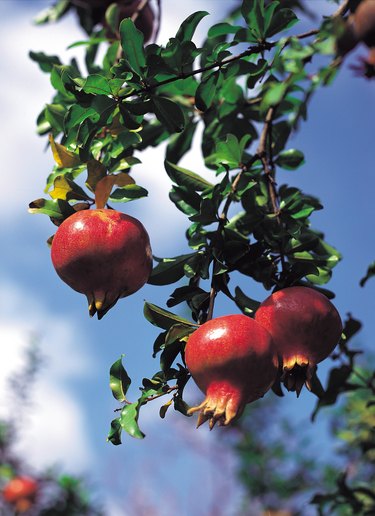
Valued for its edible fruits as well as for its colorful, showy flowers, the pomegranate (Punica granatum) has a long history of association with humankind. Typically grown as a multistemmed bush growing to 12 to 16 feet tall, pomegranate can reach a height of 20 to 30 feet. It can also be pruned to grow as a small tree. Pomegranates can live for many years -- some in Europe are more than 200 years old.
Age and Productivity
Video of the Day
A pomegranate bush or tree may flower and bear some fruit after its first year, but it usually needs two or three years to produce a full crop. Depending on the size of the plant, it will yield about 8 to pounds of fruit annually. Fruits mature five to seven months after the promegranate flowers. Wait for the promegranate to ripen before picking; once it's off the tree, it won't get any riper. Although this is a long-living plant, vigor may decline after about 15 years, according to Clemson University Cooperative Extension. In his book "The Incredible Pomegranate," Richard Ashton writes that pomegranates have been documented as old as 300 years and that they retain vigor for 25 years.
Video of the Day
Better Fruit with Good Care
Choose fruit-producing varieties such as "Wonderful," "Early Wonderful," "Granada" or "Sweet." For better production, plant at least two different varieties for cross-pollination. For the first year, water every 2 to 4 weeks during the dry season. For the first 3 years after establishment, shorten side branches annually to promote a high number of shoot tips, since this is where fruit will form. Thereafter prune only to remove dead branches or suckers. Before pruning sterilize cutting tools with a disinfectant solution such as 1 part water to 9 parts bleach, in which you would soak the blades for 2 minutes. Irrigate regularly in the absence of rain during fruit formation and ripening so fruits don't split open. In areas with high summer rainfall, fruit also splits from too much water, so choose split-resistant varieties.
Pomegranate in the Garden
Plant pomegranate in full sun for best growth and fruit production. They are winter-hardy in U.S. Department of Agriculture plant hardiness zones 8 through 10. If you grow pomegranate for its flowers, choose flowering varieties such as yellow-flowered "Flavescens" and red, double-flowered "Double Red." The dwarf varieties "State Fair" and "Nana" have abundant flowers and small, nonedible, ornamental fruits. "Nana" is more cold-hardy than other varieties, growing in USDA zones 7 through 11. Jim Wilson, in his book "Homegrown Vegetables, Fruits and Herbs," estimates pomegranate's productive garden life spans several decades, and the Department of Ornamental Horticulture at Cuyamaca College, California puts its garden life at 50 to 80 years.
For a Longer Life
To extend the useful life of a pomegranate, Ashton suggests rejuvenating 20- to 25-year-old-bushes that are losing vigor. After disinfecting your cutting tools, cut the main branches back to the ground, choosing five to six of the suckers that sprout back for the new bush. Or remove part of the old bush each year, replacing each trunk with a new sucker so fruit production continues on the old branches until the new ones become bearing. Limit the number of main trunks to three to six for best fruit production. If you have a single-trunked tree, it is best to replace the entire plant when production drops.
- California Rare Fruit Growers: Pomegranate
- University of Florida IFAS Extension: The Pomegranate
- Clemson University Cooperative Extension: Pomegranate
- University of California Davis: Fruit & Nut Research & Information: Pomegranate
- The Incredible Pomegranate; Richard Ashton, Barbara Baer & David Silverstein
- Monrovia: Dwarf Pomegranate Punica Granatum "Nana"
- Cuyamaca College: Ornamental Horticulture 170: Punica Granatum